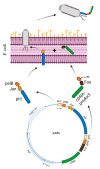Preparation of Phage Display cDNA Libraries for Identifying Immunogenic Tumor Antigens: Challenges in Functional cDNA Presentation and Approaches to Overcoming Them
- PMID: 39772164
- PMCID: PMC11680138
- DOI: 10.3390/v16121855
Preparation of Phage Display cDNA Libraries for Identifying Immunogenic Tumor Antigens: Challenges in Functional cDNA Presentation and Approaches to Overcoming Them
Abstract
Cancer continues to represent a substantial burden in terms of its morbidity and mortality, underscoring the imperative for the development of novel and efficacious treatment modalities. Recent advances in cancer immunotherapy have highlighted the importance of identifying tumour-specific antigens, which can assist the immune system in targeting malignant cells effectively. Phage display technology has emerged as an effective tool for the discovery of novel antigens through cDNA library screening, representing a significant advancement in the field of immunological research. This review examines the discovery of tumour antigens using phage display technology, emphasising the construction of cDNA libraries, their subsequent display on bacteriophages and the utilisation of diverse biopanning techniques. These elements play a pivotal role in advancing the discovery of novel tumour antigens and the development of targeted cancer therapies. This review addresses the challenges associated with the filamentous phage display of cDNA libraries and proposes strategies to improve the effectiveness of this approach, encouraging further research for clinical applications.
Keywords: biopanning; cDNA libraries; filamentous bacteriophages; immunotherapy; nanoparticles; phage display technology; tumor antigens.
Conflict of interest statement
The authors declare no conflicts of interest. The funders had no role in the design of this study; in the collection, analyses or interpretation of the data; in the writing of the manuscript; or in the decision to publish the results.
Figures



Similar articles
-
Serological cloning of cancer/testis antigens expressed in prostate cancer using cDNA phage surface display.Cancer Immunol Immunother. 2004 May;53(5):431-8. doi: 10.1007/s00262-003-0458-8. Epub 2004 Jan 28. Cancer Immunol Immunother. 2004. PMID: 14747957 Free PMC article.
-
ORF phage display to identify cellular proteins with different functions.Methods. 2012 Sep;58(1):2-9. doi: 10.1016/j.ymeth.2012.07.013. Epub 2012 Jul 23. Methods. 2012. PMID: 22836128 Free PMC article.
-
Direct selection of cDNAs from filamentous phage surface display libraries: potential and limitations.Curr Pharm Biotechnol. 2002 Mar;3(1):13-21. doi: 10.2174/1389201023378535. Curr Pharm Biotechnol. 2002. PMID: 11883503 Review.
-
Phage Display-Based Nanotechnology Applications in Cancer Immunotherapy.Molecules. 2020 Feb 14;25(4):843. doi: 10.3390/molecules25040843. Molecules. 2020. PMID: 32075083 Free PMC article. Review.
-
Phage display systems and their applications.Appl Microbiol Biotechnol. 2006 Mar;70(1):2-11. doi: 10.1007/s00253-005-0270-9. Epub 2005 Dec 20. Appl Microbiol Biotechnol. 2006. PMID: 16365766 Review.
References
-
- Hanahan D. Hallmarks of Cancer: New Dimensions. Cancer Discov. 2022;12:31–46. doi: 10.1158/2159-8290.CD-21-1059. - DOI - PubMed
Publication types
MeSH terms
Substances
Grants and funding
LinkOut - more resources
Full Text Sources
Medical

